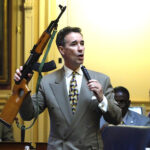
by Steve Haner
The most effective gun violence prevention idea presented to the Virginia State Crime Commission Monday was one seldom discussed in the state: Add violent misdemeanors to the list of convictions that prevent gun purchases from a licensed dealer.
Four states, including Maryland, have that provision and a Boston University study found it has lowered the firearms homicide rate better than 25 percent in those states. Right now, extending the ban from felons to violent misdemeanants is not among the scores of bills pending at Virginia’s special session on gun violence.
One of the least effective proposals, but one always at the top of many lists? Prohibiting the sale of so-called assault or assault-style rifles. The research on that is clear, Boston University research fellow Claire Boine said in one of the most useful evidence-based presentations from the long day. You can see her slides here and the full study here.
As expected, the day produced data that both gun advocates and 2nd Amendment purists could cheer, and data both will greet with disdain. Parts of the data got some media attention, but for the full list of the presentations go back to that main meetings page, here. The meeting itself continues today with public comments and then patron presentations.

Then there was the presentation that nobody else in the media seemed to notice: Diana Zuckerman of the National Center on Health Research speaking on “Does Media Coverage Inspire Copycat Mass Killings?” Yes, she said, it very much does. “It’s only a small part of the story but it is a part that will save lives.” More on that later, since the mainstream media ignored her.
Virginia Mercury’s coverage focused on the Boston University data, noting that it shows that several steps taken in combination have a significant multiplier effect. The three steps are 1) disallow sales to those with violent misdemeanors, 2) give local authorities leeway to deny concealed carry permits, and 3) widen the net on pre-sale background checks. Virginia has a highly effective system for dealer sales, but it does not extend to private sales. Number two and three have been debated here often.
The research, based on long term homicide trends in the states with these laws, found several popular talking points are not effective policies: age limits, the assault weapon ban, broad prohibitions on the mentally ill, and the highly popular ban on large capacity magazines.

It was only after she was pressed by members of the panel that presenter and co-author Boine departed from her text and indicated – for the limited question of mass shootings – a ban on large capacity magazines might be effective. The fact that she was offering an opinion outside her own data didn’t make it into many news stories.
Another idea Virginia tried in the past, and which is being pressed again, would limit guy buyers to one handgun a month. (In my head I always now hear former Delegate Clint Miller adding, “that’s two per month for a loving couple.”) Boine said their data doesn’t see that impacting gun violence in the states with that law. Of course, it was passed because many Virginia-sold guns find their way elsewhere, and still do per another presentation Monday.
Boine stayed away from both red flag laws and the many “stand your ground” laws popular with self-defense advocates, saying they are relatively new and there was not sufficient data to evaluate them yet. But the unescapable conclusion of her research, and the theme was picked up by others Monday, is that past violence is the best predictor of future violence, so try not to let violent offenders have guns.
Zuckerman’s charts on the increasing frequency of mass attacks since the University of Texas sniper attack in 1966 did get great attention. Those are slides six and seven in her 41-page packet. Equally chilling was her information on how these events, and the perpetrators, create a set of “fans and followers.”
It is well known that coverage of suicides creates copycats. About half of the mass murderers seem to be committing suicide by cop at the end, and in the cases where it ends in suicide, the body count before that point has been higher. A University of Alabama study has noted mass killers often get more news coverage than celebrities or sports stars. The murders get on and stay on the front page. Most of the research she cited dealt with traditional media, not on-line social media. Now all this plays out on Twitter.
Some of the perpetrators, not all of them but some of them, are doing it for the fame and notoriety, the research indicates – perhaps 30%. Her suggestion was that the media stop granting that in such massive proportions. She talked about an approach the FBI calls “Don’t Name Them” that has worked with suicides and could work with mass murders. Not publishing any manifesto is an obvious way to deny the murderer what they want.
With social media so pervasive, restraint by the mainstream media likely would have less impact than in the past. But the question is often posed, why are things so different now than decades ago? Why this obvious acceleration of these tragedies? The copycat phenomena coupled with the explosion of mass and social media is probably part of the answer.

Leave a Reply
You must be logged in to post a comment.